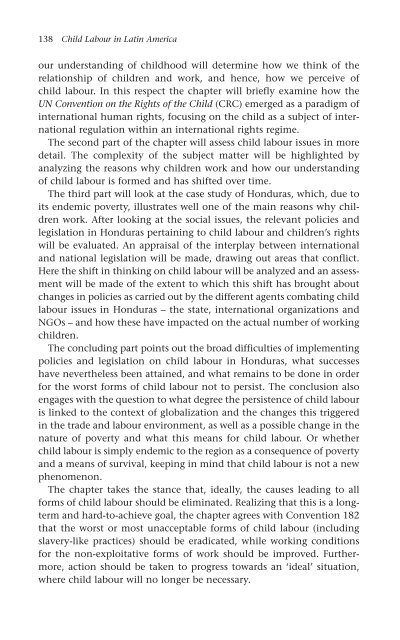3071-The political economy of new slavery
3071-The political economy of new slavery
3071-The political economy of new slavery
You also want an ePaper? Increase the reach of your titles
YUMPU automatically turns print PDFs into web optimized ePapers that Google loves.
138 Child Labour in Latin America<br />
our understanding <strong>of</strong> childhood will determine how we think <strong>of</strong> the<br />
relationship <strong>of</strong> children and work, and hence, how we perceive <strong>of</strong><br />
child labour. In this respect the chapter will briefly examine how the<br />
UN Convention on the Rights <strong>of</strong> the Child (CRC) emerged as a paradigm <strong>of</strong><br />
international human rights, focusing on the child as a subject <strong>of</strong> international<br />
regulation within an international rights regime.<br />
<strong>The</strong> second part <strong>of</strong> the chapter will assess child labour issues in more<br />
detail. <strong>The</strong> complexity <strong>of</strong> the subject matter will be highlighted by<br />
analyzing the reasons why children work and how our understanding<br />
<strong>of</strong> child labour is formed and has shifted over time.<br />
<strong>The</strong> third part will look at the case study <strong>of</strong> Honduras, which, due to<br />
its endemic poverty, illustrates well one <strong>of</strong> the main reasons why children<br />
work. After looking at the social issues, the relevant policies and<br />
legislation in Honduras pertaining to child labour and children’s rights<br />
will be evaluated. An appraisal <strong>of</strong> the interplay between international<br />
and national legislation will be made, drawing out areas that conflict.<br />
Here the shift in thinking on child labour will be analyzed and an assessment<br />
will be made <strong>of</strong> the extent to which this shift has brought about<br />
changes in policies as carried out by the different agents combating child<br />
labour issues in Honduras – the state, international organizations and<br />
NGOs – and how these have impacted on the actual number <strong>of</strong> working<br />
children.<br />
<strong>The</strong> concluding part points out the broad difficulties <strong>of</strong> implementing<br />
policies and legislation on child labour in Honduras, what successes<br />
have nevertheless been attained, and what remains to be done in order<br />
for the worst forms <strong>of</strong> child labour not to persist. <strong>The</strong> conclusion also<br />
engages with the question to what degree the persistence <strong>of</strong> child labour<br />
is linked to the context <strong>of</strong> globalization and the changes this triggered<br />
in the trade and labour environment, as well as a possible change in the<br />
nature <strong>of</strong> poverty and what this means for child labour. Or whether<br />
child labour is simply endemic to the region as a consequence <strong>of</strong> poverty<br />
and a means <strong>of</strong> survival, keeping in mind that child labour is not a <strong>new</strong><br />
phenomenon.<br />
<strong>The</strong> chapter takes the stance that, ideally, the causes leading to all<br />
forms <strong>of</strong> child labour should be eliminated. Realizing that this is a longterm<br />
and hard-to-achieve goal, the chapter agrees with Convention 182<br />
that the worst or most unacceptable forms <strong>of</strong> child labour (including<br />
<strong>slavery</strong>-like practices) should be eradicated, while working conditions<br />
for the non-exploitative forms <strong>of</strong> work should be improved. Furthermore,<br />
action should be taken to progress towards an ‘ideal’ situation,<br />
where child labour will no longer be necessary.


